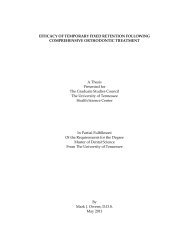BEVACIZUMAB EFFECT ON TOPOTECAN PHARMACOKINETICS ...
BEVACIZUMAB EFFECT ON TOPOTECAN PHARMACOKINETICS ...
BEVACIZUMAB EFFECT ON TOPOTECAN PHARMACOKINETICS ...
Create successful ePaper yourself
Turn your PDF publications into a flip-book with our unique Google optimized e-Paper software.
However, the window for human U87 tumor model is transient and only lasts about 5<br />
days.<br />
1.2.4 BEV in preclinical studies<br />
Numerous studies have been conducted to investigate the pharmacological effect<br />
of BEV in solid tumor xenograft models. Investigators have mainly focused on tumor<br />
growth inhibition via disruption of tumor vasculature and the inhibition of tumor<br />
metastasis.<br />
In general, studies of the anti-VEGF effect usually employed vascular changes<br />
and tumor growth inhibition as primary end points and have showed that BEV<br />
significantly decreased vessel density and tumor growth regardless of tumor types. Dr.<br />
Finn et al. showed that administration of BEV 5 mg/kg intra-peritoneal twice a week<br />
significantly decreased microvessel density, decreased human serum alpha-fetoprotein<br />
and delayed tumor progression for treated mice compared to the controls in a human<br />
hepatocellular orthotopic xenograft model [82]. Dr. Okada et al. administered BEV 2<br />
mg/kg intra-peritoneal twice a week for 8 weeks and found that BEV significantly<br />
inhibited tumor growth by 48% in volume at the end of the experiment [83]. Meanwhile,<br />
the intratumoral microvessel density was significantly decreased in the BEV treatment<br />
group compared to the control group and a positive correlation was found between tumor<br />
volume and microvessel density.<br />
VEGF plays a critical role in the tumor angiogenesis and angiogenesis is a feature<br />
of growth and invasion in primary neoplasms and their metastases. Furthermore, BEV<br />
has been shown to control metastatic colorectal carcinoma, metastatic breast carcinoma,<br />
and metastatic non–small cell lung carcinoma [84-86]. However, there are also several<br />
case reports about more cancer metastasis after BEV treatment [87, 88]. Thus some<br />
investigators start to assess the anti-VEGF effect on tumor metastasis. Imaizumi et al.<br />
used a peritoneal metastasis model to determine the effect of BEV on peritoneal<br />
dissemination from gastric cancer and showed BEV had a significant effect on peritoneal<br />
dissemination suppression [89]. More directly, Dr. Yang et al. examined the effect of<br />
BEV on tumor cell survival, invasiveness in vitro and metastasis in vivo [90]. The results<br />
showed that BEV decreased in vitro growth and invasion and further suppressed in vivo<br />
hepatic metastasis of ocular melanoma cells.<br />
Based on the promising tumor vasculature and growth inhibitory effects of BEV<br />
in preclinical models, the application of BEV was moved forward to clinical trials.<br />
1.2.5 BEV in patients<br />
Although BEV showed a significant effect on tumor vasculature changes, tumor<br />
growth, metastasis and survival rate in preclinical studies, BEV alone only provides<br />
modest survival benefits in patients [91]. However, it showed that anti-VEGF treatment<br />
7
















